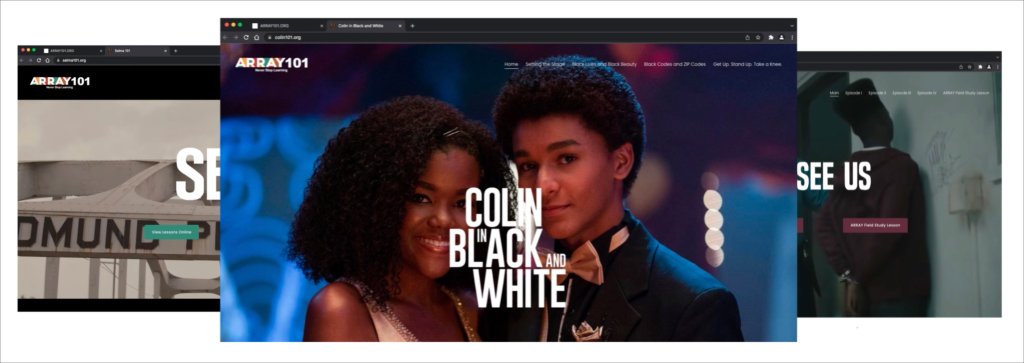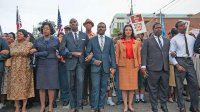Using Films to Explore Social Justice Issues
Lesson plans for Ava DuVernay’s films and television series guide students to explore social justice issues in the classroom.
Your content has been saved!
Go to My Saved Content.How can teachers ensure that students learn from films and television series that they teach in class? Ava DuVernay, whose films and series include Selma, Colin in Black & White, When They See Us, 13th, and Queen Sugar, wondered just that. Covering themes of Black family dynamics, race relations, and social justice issues in the United States, DuVernay knew that her works were screened in classrooms as a catalyst to inspire discussion. She saw an opportunity to contribute to the educational community. In 2020, ARRAY 101 was launched—a set of free and robust online social impact lesson plans or “learning companions” to accompany her films.
Anatomy of the Learning Companions
Lesson plans in each learning companion can be easily modified, remixed, and adapted by teachers to meet their students’ needs. Each learning companion contains the following sections:
- Themes
- Objectives and Key Points
- Essential Questions
- Classroom Activities
- Resources for Self-Reflection and Deeper Learning

The learning companions focus on race relations and social justice issues, in the past and present day. For example, some lesson plans focus on how the Jim Crow laws, a derivative of “black codes,” still reverberate today. In the post–Reconstruction Era, state and local laws disenfranchised Black voters by restricting access to polling centers. Students also learn about how nearly 2,000 Black Americans, including formerly enslaved people, were elected to serve in political office during Reconstruction.
There are myriad ways that the learning companions can be used to support teaching, including as standalone units and integrated into existing lessons.
Teaching Social Justice through ’Selma‘
DuVernay’s 2014 Academy Award–nominated Selma focuses on three months in 1965 in the life of Dr. Martin Luther King Jr. During that time, King led a group of nonviolent civil rights demonstrators from Selma, Alabama, to the state’s capital of Montgomery. The Selma marchers were met with violence as they crossed the Edmund Pettus Bridge. This violence was broadcast on television and is considered a turning point in the Civil Rights Movement, prompting President Lyndon Johnson to send the Voting Rights Act of 1965 to Congress. The film dramatizes these events as it explores the humanity of King and the late Sen. John Lewis.
After watching the movie, educators may want to create teachable moments that help students contextualize what they just saw. ARRAY 101’s Selma learning companion provides structure that teachers can use to do just that. “You just watched a two-hour movie about Dr. King,” Tammy Garnes, the vice president of Education and Understanding at ARRAY, explains. “We now want to talk about you, your community, what voting rights look like in your city, your county, your state. Whether or not your district is gerrymandered. How do you recognize that? What do you do about it? How does it impact you and your family? And what choices are being made on your behalf that come from being in a district that might be gerrymandered.”
In addition to social studies and civics alignment, the interdisciplinary lesson plans include a geometry activity where students analyze the shapes of voting districts.
The Selma 101 lessons connect civil rights to current issues affecting students’ lives. A set of three lessons—“I Voted,” “The Art of Persuasion,” and “Anatomy of a Protest”—guides students to think through the social implications of Selma.
The first lesson focuses on the nuanced differences between equity and equality. Students are then asked to engage in debate and persuasive writing, culminating with the “Anatomy of a Protest” project-based learning assignment, where students create a protest playbook, much as King did. Students research a cause they are interested in defending, create a logo and slogan, and choose the type of activism (e.g., online petitions, boycotts). Students then reflect on metrics needed to measure the success of their protest. Students can compare their plan to King’s as they consider why boycotts or marches were used for certain issues but not others.
Integrating ARRAY 101 Materials into Lesson Plans
Teachers may already be focusing on social justice issues in their classrooms. In addition to the Selma learning companion, here are additional ways that ARRAY 101 materials can complement lessons.
Queen Sugar, a drama about Black entrepreneurship, just completed its seven-season run on television. The series covers themes of intergenerational family dynamics and the legacy of racial injustice and presents various ways to link the show to learning objectives. Lessons focus on the history of land ownership, protest, ancestral religious practices, and the rights of the formerly incarcerated. The Learning Companion features an interactive timeline and digital map from the 1700s to today, which can be projected on a screen. By doing so, students can visualize how characters in Queen Sugar, as well as New Orleans itself, developed and changed over time.
Colin in Black & White is a Netflix series based on the childhood of former NFL quarterback Colin Kaepernick. Students may relate, as the series covers his experiences in high school with activities that pertain to social constructivism of race, power, and identity. In one lesson, students analyze coded language and bias, including how Black hairstyles and fashion are sometimes marginalized in the workplace and at schools. Next, in a geography lesson, students examine the socioeconomic status of zip codes, including the ones where they live. Students then discuss why there are “better” and “worse” parts of towns and what that bias might imply.
The ARRAY 101 learning companions model how teachers can design movie-based lessons on social justice the way they would with books. Whether stories are written or visually told, narratives add nuance and relevance to important conversations around race relations and the American journey.
